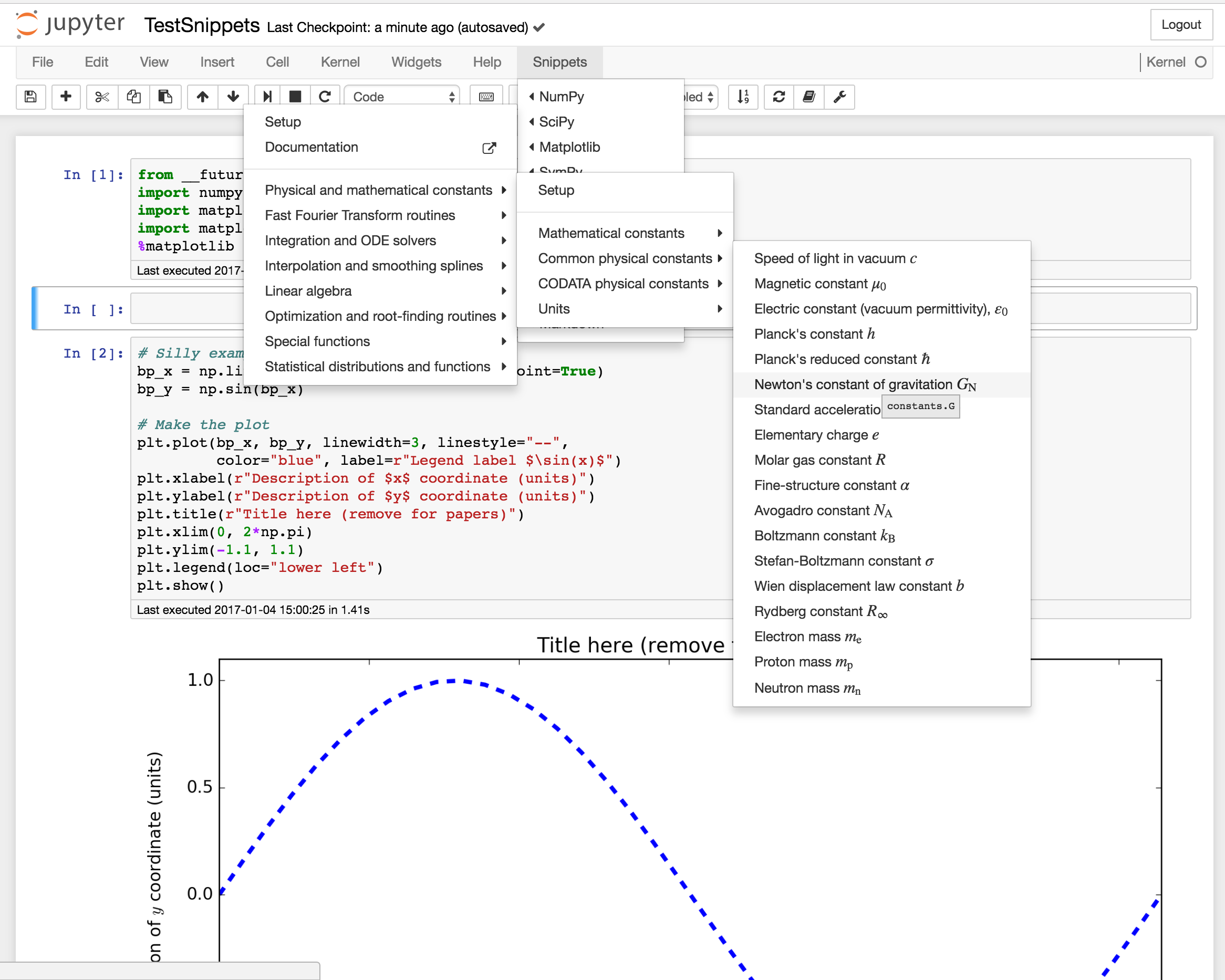- Jupyter Tutorial
Jupyter 노트북에 수학 공식을 작성하고 싶습니다. 라텍스는 마크 다운으로 만드는 간단한 방법 인 것 같습니다. 나는 여러 링크를 겪었지만 모두 그들에게. I want to get html from markdown on Jupyter Notebook. Given a list of numbers and a number, return whether any two numbers from the list add up to.
- Most Popular Sites That List Vscode Jupyter Notebook Markdown. Below are 43 working coupons for Vscode Jupyter Notebook Markdown from reliable websites.
- Markdown and Visual Studio Code. Working with Markdown files in Visual Studio Code is simple, straightforward, and fun. Besides VS Code's basic editing, there are a number of Markdown specific features that will help you be more productive.
- IPython
- Jupyter
- QtConsole
- JupyterLab
- Jupyter Resources
- Selected Reading
Markdown cell displays text which can be formatted using markdown language. In order to enter a text which should not be treated as code by Notebook server, it must be first converted as markdown cell either from cell menu or by using keyboard shortcut M while in command mode. The In[] prompt before cell disappears.

Header cell
A markdown cell can display header text of 6 sizes, similar to HTML headers. Start the text in markdown cell by # symbol. Use as many # symbols corresponding to level of header you want. It means single # will render biggest header line, and six # symbols renders header of smallest font size. The rendering will take place when you run the cell either from cell menu or run button of toolbar.
Following screenshot shows markdown cells in edit mode with headers of three different levels.
When cells are run, the output is as follows −
Note that Jupyter notebook markdown doesn’t support WYSWYG feature. The effect of formatting will be rendered only after the markdown cell is run.
Ordered Lists
To render a numbered list as is done by <ol> tag of HTML, the First item in the list should be numbered as 1. Subsequent items may be given any number. It will be rendered serially when the markdown cell is run. To show an indented list, press tab key and start first item in each sublist with 1.
If you give the following data for markdown −
It will display the following list −
Bullet lists
Each item in the list will display a solid circle if it starts with – symbol where as solid square symbol will be displayed if list starts with * symbol. The following example explains this feature −
The rendered markdown shows up as below −
Hyperlinks
Markdown text starting with http or https automatically renders hyperlink. To attach link to text, place text in square brackets [] and link in parentheses () optionally including hovering text. Following screenshot will explain this.
The rendered markdown appears as shown below −
Bold and Italics
To show a text in bold face, put it in between double underscores or two asterisks. To show in italics, put it between single underscores or single asterisks.

The result is as shown below −
Images


To display image in a markdown cell, choose ‘Insert image’ option from Edit menu and browse to desired image file. The markdown cell shows its syntax as follows −
Mysql manager for mac os. Image will be rendered on the notebook as shown below −
Table
In a markdown cell, a table can be constructed using | (pipe symbol) and – (dash) to mark columns and rows. Note that the symbols need not be exactly aligned while typing. It should only take respective place of column borders and row border. Notebook will automatically resize according to content. A table is constructed as shown below −
The output table will be rendered as shown below −
Using the Go extension for Visual Studio Code, you get features like IntelliSense, code navigation, symbol search, testing, debugging, and many more that will help you in Go development.
You can install the Go extension from the VS Code Marketplace.
Watch 'Getting started with VS Code Go' for an explanation of how to build your first Go application using VS Code Go.
This article describes only a subset of the features the Go extension provides. See the extension's documentation for the full, up-to-date list of supported features.
IntelliSense

IntelliSense features are provided by the Go language server, gopls, maintained by the Go team. You can configure the behavior of gopls using the gopls settings.
Auto completions
As you type in a Go file, you can see IntelliSense providing you with suggested completions. This even works for members in current, imported, and not yet imported packages. Just type any package name followed by ., and you will get suggestions for the corresponding package members.
Tip: Use ⌃Space (Windows, Linux Ctrl+Space) to trigger the suggestions manually.
Hover Information
Hovering on any variable, function, or struct will give you information on that item such as documentation, signature, etc. Vray for maya mac torrent.
Nested List Markdown Jupyter
Signature help
When you open the ( while calling a function, a pop-up provides signature help for the function. As you keep typing the parameters, the hint (underline) moves to the next parameter.
Tip: Use ⇧⌘Space (Windows, Linux Ctrl+Shift+Space) to manually trigger the signature help when the cursor is inside the () in the function call.
Code navigation
Code navigation features are available in the context menu in the editor.
- Go To DefinitionF12 - Go to the source code of the type definition.
- Peek Definition⌥F12 (Windows Alt+F12, Linux Ctrl+Shift+F10) - Bring up a Peek window with the type definition.
- Go to References⇧F12 (Windows, Linux Shift+F12) - Show all references for the type.
- Show Call Hierarchy⇧⌥H (Windows, Linux Shift+Alt+H) - Show all calls from or to a function.
You can navigate via symbol search using the Go to Symbol commands from the Command Palette (⇧⌘P (Windows, Linux Ctrl+Shift+P)).
- Go to Symbol in File - ⇧⌘O (Windows, Linux Ctrl+Shift+O)
- Go to Symbol in Workspace - ⌘T (Windows, Linux Ctrl+T)
Gta for free mac. You can also navigate back and forth between a Go file and its test implementation using the Go: Toggle Test File command.
Build, test, and diagnose
The Go language server (gopls) detects build and vet errors found on the workspace. The errors and warnings from running any/all of the above will be shown red/green squiggly lines in the editor. These diagnostics also show up in the Problems panel (View > Problems).
You can add additional lint checks using the go.lintOnSave setting and configuring your choice of linting tool (staticcheck, golangci-lint, or revive) using the go.listTool setting.
You can configure the extension to run tests and compute test coverage using:
go.testOnSavego.coverOnSavego.testFlags
Formatting
You can format your Go file using ⇧⌥F (Windows Shift+Alt+F, Linux Ctrl+Shift+I) or by running the Format Document command from the Command Palette or the context menu in the editor.
By default, formatting is run when you save your Go file. You can disable this behavior by setting editor.formatOnSave to false for the [go] language identifier. You can change this using your JSON setting files.
When you have multiple formatters activated for Go files, you can select the Go extension as the default formatter.
Formatting is provided by gopls. If you want gofumpt-style formatting, you can configure gopls to use gofumpt.
Test
There are many test-related commands that you can explore by typing Go: test in the Command Palette.
List Markdown Jupiter Island
The first three above can be used to generate test skeletons for the functions in the current package, file, or at the cursor using gotests. The last few can be used to run tests in the current package, file, or at the cursor using go test. There is also a command for getting test coverage.
Import packages
Run the command Go: Add Import to get a list of packages that can be imported to your Go file. Choose one and it will get added in the import block of your Go file.
Rename symbols
You can rename symbols using F2 or by running the Rename Symbol command in the context menu in the editor.
Debugging
The Go extension lets you debug Go code as well. You will need to install the Delve debugger manually as a prerequisite. Read Debug Go programs in VS Code for setup steps, information on remote debugging and a troubleshooting guide.
Next steps
This has been a brief overview showing the Go extension features within VS Code. For more information, see the details provided in the Go extension README.
To stay up to date on the latest features/bug fixes for the Go extension, see the CHANGELOG.
If you have any issues or feature requests, feel free to log them in the Go extension vscode-go repo.
If you'd like to learn more about VS Code, try these topics:
Numbered List Markdown Jupyter
- Basic Editing - A quick introduction to the basics of the VS Code editor.
- Install an Extension - Learn about other extensions are available in the Marketplace.
- Code Navigation - Move quickly through your source code.
